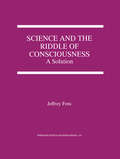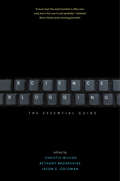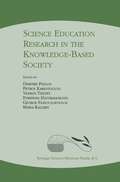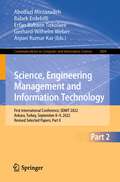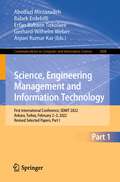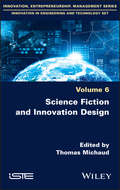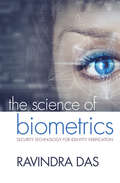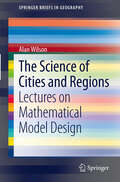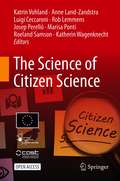- Table View
- List View
Science and Technologies for Smart Cities: 5th EAI International Summit, SmartCity360, Braga, Portugal, December 4-6, 2019, Proceedings (Lecture Notes of the Institute for Computer Sciences, Social Informatics and Telecommunications Engineering #323)
by Henrique Santos Gabriela Viale Pereira Matthias Budde Sérgio F. Lopes Predrag NikolicThis book constitutes the refereed proceedings of the 5th Annual Smart City 360° Summit, held in Braga, Portugal, in December 2019. The volume combines selected papers of four conferences, namely IoT in Urban Space, Urb-IoT 2019, Smart Governance for Sustainable Smart Cities, SmartGov 2019, Sensor Systems and Software, S-Cube 2019, and Intelligent Technologies for Interactive Entertainment, Intetain 2019. The 5 keynote and 32 conference papers presented were carefully reviewed and selected from 113 submissions and present results of multidisciplinary scientific and industry collaboration to solve complex societal, technological and economic problems Smart Cities. As such, the main goals are to promote quality of life, work conditions, mobility and sustainability.
The Science and Technology of Counterterrorism: Measuring Physical and Electronic Security Risk
by Carl YoungScientists with little or no background in security and security professionals with little or no background in science and technology often have difficulty communicating in order to implement the best counterterrorism strategies. The Science and Technology of Counterterrorism offers the necessary theoretical foundation to address real-world terrorism scenarios, effectively bridging the gap. It provides a powerful security assessment methodology, coupled with counterterrorism strategies that are applicable to all terrorism attack vectors. These include biological, chemical, radiological, electromagnetic, explosive, and electronic or cyber attacks. In addition to rigorous estimates of threat vulnerabilities and the effectiveness of risk mitigation, it provides meaningful terrorism risk metrics. The Science and Technology of Counterterrorism teaches the reader how to think about terrorism risk, and evaluates terrorism scenarios and counterterrorism technologies with sophistication punctuated by humor. Both students and security professionals will significantly benefit from the risk assessment methodologies and guidance on appropriate counterterrorism measures contained within this book.Offers a simple but effective analytic framework to assess counterterrorism risk and realistic measures to address threatsProvides the essential scientific principles and tools required for this analysisExplores the increasingly important relationship between physical and electronic risk in meaningful technical detailEvaluates technical security systems to illustrate specific risks using concrete examples
Science and the Riddle of Consciousness: A Solution
by Jeffrey E. FossConsciousness has become a major topic of scientific interest, and dozens of books have been written in recent years to explain it, yet it still remains a mystery. Science and the Riddle of Consciousness explains why consciousness is a riddle for science, and demonstrates how this riddle can be solved. The questions examined in the book speak directly to neuroscientists, computer scientists, psychologists, and philosophers.
Science between Europe and Asia: Historical Studies on the Transmission, Adoption and Adaptation of Knowledge (Boston Studies in the Philosophy and History of Science #275)
by Feza Günergun and Dhruv RainaThis book explores the various historical and cultural aspects of scientific, medical and technical exchanges that occurred between central Europe and Asia. A number of papers investigate the printing, gunpowder, guncasting, shipbuilding, metallurgical and drilling technologies while others deal with mapping techniques, the adoption of written calculation and mechanical clocks as well as the use of medical techniques such as pulse taking and electrotherapy. While human mobility played a significant role in the exchange of knowledge, translating European books into local languages helped the introduction of new knowledge in mathematical, physical and natural sciences from central Europe to its periphery and to the Middle East and Asian cultures. The book argues that the process of transmission of knowledge whether theoretical or practical was not a simple and one-way process from the donor to the receiver as it is often admitted, but a multi-dimensional and complex cultural process of selection and transformation where ancient scientific and local traditions and elements. The book explores the issue from a different geopolitical perspective, namely not focusing on a singular recipient and several points of distribution, namely the metropolitan centres of science, medicine, and technology, but on regions that are both recipients and distributors and provides new perspectives based on newly investigated material for historical studies on the cross scientific exchanges between different parts of the world.
Science Blogging: The Essential Guide
by Christie Wilcox Bethany Brookshire Jason G. GoldmanHere is the essential how-to guide for communicating scientific research and discoveries online, ideal for journalists, researchers, and public information officers looking to reach a wide lay audience. Drawing on the cumulative experience of twenty-seven of the greatest minds in scientific communication, this invaluable handbook targets the specific questions and concerns of the scientific community, offering help in a wide range of digital areas, including blogging, creating podcasts, tweeting, and more. With step-by-step guidance and one-stop expertise, this is the book every scientist, science writer, and practitioner needs to approach the Wild West of the Web with knowledge and confidence.
Science Education Research in the Knowledge-Based Society
by Dimitris Psillos Petros Kariotoglou Vassilis Tselfes Euripides Hatzikraniotis George Fassoulopoulos Maria KalleryThis book offers a global presentation of issues under study for improving science education research in the context of the knowledge-based society at a European and international level. It includes discussions of several theoretical approaches, research overviews, research methodologies, and the teaching and learning of science. It is based on papers presented at the Third International Conference of the European Science Education Research Association (Thessaloniki, Greece, August 2001).
Science, Engineering Management and Information Technology: First International Conference, SEMIT 2022, Ankara, Turkey, September 8-9, 2022, Revised Selected Papers, Part II (Communications in Computer and Information Science #1809)
by Abolfazl Mirzazadeh Babek Erdebilli Erfan Babaee Tirkolaee Gerhard-Wilhelm Weber Arpan Kumar KarThis two-volume set constitutes selected papers presented during the First First International Conference on Science, Engineering Management and Information Technology, SEMIT 2022, held virtually in Ankara, Turkey, in February 2–3, 2022 and in September 8-9, 2022. The 37 papers presented were carefully reviewed and selected from the 261 qualified submissions. The papers are organized in the following topical sections: application of computer science and technology in operations and supply chain management; advances of engineering technology and Artificial Intelligence in application management; technology-aided decision-making: systems, applications, and modern solutions.
Science, Engineering Management and Information Technology: First International Conference, SEMIT 2022, Ankara, Turkey, February 2–3, 2022, Revised Selected Papers, Part I (Communications in Computer and Information Science #1808)
by Abolfazl Mirzazadeh Babek Erdebilli Erfan Babaee Tirkolaee Gerhard-Wilhelm Weber Arpan Kumar KarThis two-volume set constitutes selected papers presented during the First First International Conference on Science, Engineering Management and Information Technology, SEMIT 2022, held virtually in Ankara, Turkey, in February 2–3, 2022 and in September 8-9, 2022. The 37 papers presented were carefully reviewed and selected from the 261 qualified submissions. The papers are organized in the following topical sections: application of computer science and technology in operations and supply chain management; advances of engineering technology and Artificial Intelligence in application management; human factors management systems based on information technology; technology-aided decision-making: systems, applications, and modern solutions.
Science Fiction and Innovation Design
by Thomas MichaudScience fiction is often presented as a source of utopia, or even of prophecies, used in capitalism to promote social, political and technoscientific innovations. Science Fiction and Innovation Design assesses the validity of this approach by exploring the impact this imaginary world has on the creativity of engineers and researchers. Companies seek to anticipate and predict the future through approaches such as design fiction: mobilizing representations of science fiction to create prototypes and develop scenarios relevant to organizational strategy. The conquest of Mars or the weapons of the future are examples developed by authors to demonstrate how design innovation involves continuous dialogue between multiple players, from the scientist to the manager, through to the designers and the science fiction writers.
Science Fiction and Innovation Design
by Thomas MichaudScience fiction is often presented as a source of utopia, or even of prophecies, used in capitalism to promote social, political and technoscientific innovations. Science Fiction and Innovation Design assesses the validity of this approach by exploring the impact this imaginary world has on the creativity of engineers and researchers. Companies seek to anticipate and predict the future through approaches such as design fiction: mobilizing representations of science fiction to create prototypes and develop scenarios relevant to organizational strategy. The conquest of Mars or the weapons of the future are examples developed by authors to demonstrate how design innovation involves continuous dialogue between multiple players, from the scientist to the manager, through to the designers and the science fiction writers.
Science Fiction Prototyping: Designing the Future with Science Fiction (Synthesis Lectures on Computer Science)
by Johnson Brian DavidScience fiction is the playground of the imagination. If you are interested in science or fascinated with the future then science fiction is where you explore new ideas and let your dreams and nightmares duke it out on the safety of the page or screen. But what if we could use science fiction to do more than that? What if we could use science fiction based on science fact to not only imagine our future but develop new technologies and products? What if we could use stories, movies and comics as a kind of tool to explore the real world implications and uses of future technologies today? Science Fiction Prototyping is a practical guide to using fiction as a way to imagine our future in a whole new way. Filled with history, real world examples and conversations with experts like best selling science fiction author Cory Doctorow, senior editor at Dark Horse Comics Chris Warner and Hollywood science expert Sidney Perkowitz, Science Fiction Prototyping will give you the tools you need to begin designing the future with science fiction. The future is Brian David Johnson’s business. As a futurist at Intel Corporation, his charter is to develop an actionable vision for computing in 2021. His work is called “future casting”—using ethnographic field studies, technology research, trend data, and even science fiction to create a pragmatic vision of consumers and computing. Johnson has been pioneering development in artificial intelligence, robotics, and reinventing TV. He speaks and writes extensively about future technologies in articles and scientific papers as well as science fiction short stories and novels (Fake Plastic Love and Screen Future: The Future of Entertainment, Computing and the Devices We Love). He has directed two feature films and is an illustrator and commissioned painter. Table of Contents: Preface / Foreword / Epilogue / Dedication / Acknowledgments / 1. The Future Is in Your Hands / 2. Religious Robots and Runaway Were-Tigers: A Brief Overview of the Science and the Fiction that Went Into Two SF Prototypes / 3. How to Build Your Own SF Prototype in Five Steps or Less / 4. I, Robot: From Asimov to Doctorow: Exploring Short Fiction as an SF Prototype and a Conversation With Cory Doctorow / 5. The Men in the Moon: Exploring Movies as an SF Prototype and a Conversation with Sidney Perkowitz / 6. Science in the Gutters: Exploring Comics as an SF Prototype and a Conversation With Chris Warner / 7. Making the Future: Now that You Have Developed Your SF Prototype, What’s Next? / 8. Einstein’s Thought Experiments and Asimov’s Second Dream / Appendix A: The SF Prototypes / Notes / Author Biography
Science Fiction Video Games
by Neal Roger TringhamUnderstand Video Games as Works of Science Fiction and Interactive Stories Science Fiction Video Games focuses on games that are part of the science fiction genre, rather than set in magical milieux or exaggerated versions of our own world. Unlike many existing books and websites that cover some of the same material, this book emphasizes critical a
Science Gateways for Distributed Computing Infrastructures: Development Framework and Exploitation by Scientific User Communities
by Péter KacsukThe book describes the science gateway building technology developed in the SCI-BUS European project and its adoption and customization method, by which user communities, such as biologists, chemists, and astrophysicists, can build customized, domain-specific science gateways. Many aspects of the core technology are explained in detail, including its workflow capability, job submission mechanism to various grids and clouds, and its data transfer mechanisms among several distributed infrastructures.The book will be useful for scientific researchers and IT professionals engaged in the development of science gateways.
Science in the Age of Computer Simulation
by Eric WinsbergComputer simulation was first pioneered as a scientific tool in meteorology and nuclear physics in the period following World War II, but it has grown rapidly to become indispensible in a wide variety of scientific disciplines, including astrophysics, high-energy physics, climate science, engineering, ecology, and economics. Digital computer simulation helps study phenomena of great complexity, but how much do we know about the limits and possibilities of this new scientific practice? How do simulations compare to traditional experiments? And are they reliable? Eric Winsberg seeks to answer these questions in Science in the Age of Computer Simulation. Scrutinizing these issue with a philosophical lens, Winsberg explores the impact of simulation on such issues as the nature of scientific evidence; the role of values in science; the nature and role of fictions in science; and the relationship between simulation and experiment, theories and data, and theories at different levels of description. Science in the Age of Computer Simulation will transform many of the core issues in philosophy of science, as well as our basic understanding of the role of the digital computer in the sciences.
Science in the Age of Computer Simulation
by Eric WinsbergComputer simulation was first pioneered as a scientific tool in meteorology and nuclear physics in the period following World War II, but it has grown rapidly to become indispensible in a wide variety of scientific disciplines, including astrophysics, high-energy physics, climate science, engineering, ecology, and economics. Digital computer simulation helps study phenomena of great complexity, but how much do we know about the limits and possibilities of this new scientific practice? How do simulations compare to traditional experiments? And are they reliable? Eric Winsberg seeks to answer these questions in Science in the Age of Computer Simulation. Scrutinizing these issue with a philosophical lens, Winsberg explores the impact of simulation on such issues as the nature of scientific evidence; the role of values in science; the nature and role of fictions in science; and the relationship between simulation and experiment, theories and data, and theories at different levels of description. Science in the Age of Computer Simulation will transform many of the core issues in philosophy of science, as well as our basic understanding of the role of the digital computer in the sciences.
Science in the Age of Computer Simulation
by Eric WinsbergComputer simulation was first pioneered as a scientific tool in meteorology and nuclear physics in the period following World War II, but it has grown rapidly to become indispensible in a wide variety of scientific disciplines, including astrophysics, high-energy physics, climate science, engineering, ecology, and economics. Digital computer simulation helps study phenomena of great complexity, but how much do we know about the limits and possibilities of this new scientific practice? How do simulations compare to traditional experiments? And are they reliable? Eric Winsberg seeks to answer these questions in Science in the Age of Computer Simulation. Scrutinizing these issue with a philosophical lens, Winsberg explores the impact of simulation on such issues as the nature of scientific evidence; the role of values in science; the nature and role of fictions in science; and the relationship between simulation and experiment, theories and data, and theories at different levels of description. Science in the Age of Computer Simulation will transform many of the core issues in philosophy of science, as well as our basic understanding of the role of the digital computer in the sciences.
Science Learning and Inquiry with Technology (Ed Psych Insights)
by Diane Jass Ketelhut Michael Shane TutwilerWhen implemented effectively, technology has great potential to positively connect with learning, assessment, and motivation in the context of K–12 science education and inquiry. Written by leading experts on technology-enhanced science learning and educational research, this book situates the topic within the broader context of educational psychology research and theory and brings it to a wider audience. With chapters on the fundamentals of science learning and assessment, integration of technology into classrooms, and examples of specific technologies, this concise volume is designed for any course on science learning that includes technology use in the curriculum. It will be indispensable for student researchers and both pre- and in-service teachers alike.
Science Learning and Inquiry with Technology (Ed Psych Insights)
by Diane Jass Ketelhut Michael Shane TutwilerWhen implemented effectively, technology has great potential to positively connect with learning, assessment, and motivation in the context of K–12 science education and inquiry. Written by leading experts on technology-enhanced science learning and educational research, this book situates the topic within the broader context of educational psychology research and theory and brings it to a wider audience. With chapters on the fundamentals of science learning and assessment, integration of technology into classrooms, and examples of specific technologies, this concise volume is designed for any course on science learning that includes technology use in the curriculum. It will be indispensable for student researchers and both pre- and in-service teachers alike.
Science Learning and Instruction: Taking Advantage of Technology to Promote Knowledge Integration
by Marcia C. Linn Bat-Sheva EylonScience Learning and Instruction describes advances in understanding the nature of science learning and their implications for the design of science instruction. The authors show how design patterns, design principles, and professional development opportunities coalesce to create and sustain effective instruction in each primary scientific domain: earth science, life science, and physical science. Calling for more in depth and less fleeting coverage of science topics in order to accomplish knowledge integration, the book highlights the importance of designing the instructional materials, the examples that are introduced in each scientific domain, and the professional development that accompanies these materials. It argues that unless all these efforts are made simultaneously, educators cannot hope to improve science learning outcomes. The book also addresses how many policies, including curriculum, standards, guidelines, and standardized tests, work against the goal of integrative understanding, and discusses opportunities to rethink science education policies based on research findings from instruction that emphasizes such understanding.
Science Learning and Instruction: Taking Advantage of Technology to Promote Knowledge Integration
by Marcia C. Linn Bat-Sheva EylonScience Learning and Instruction describes advances in understanding the nature of science learning and their implications for the design of science instruction. The authors show how design patterns, design principles, and professional development opportunities coalesce to create and sustain effective instruction in each primary scientific domain: earth science, life science, and physical science. Calling for more in depth and less fleeting coverage of science topics in order to accomplish knowledge integration, the book highlights the importance of designing the instructional materials, the examples that are introduced in each scientific domain, and the professional development that accompanies these materials. It argues that unless all these efforts are made simultaneously, educators cannot hope to improve science learning outcomes. The book also addresses how many policies, including curriculum, standards, guidelines, and standardized tests, work against the goal of integrative understanding, and discusses opportunities to rethink science education policies based on research findings from instruction that emphasizes such understanding.
Science Mapping of Digital Transformation in Business: A Bibliometric Analysis and Research Outlook (SpringerBriefs in Business)
by Cristina Bota-AvramDigital transformation will affect every company or organization sooner or later, regardless of the industry, country, or type of organization. In recent years, this impact has become disruptive, and there is an increasing need for companies to innovate their business models while using various emerging technologies. The key goals of this book are twofold. The first goal is to provide a comprehensive overview of the state of digital transformation in business using various bibliometric indicators, while the second goal is to propose a synthesis of the potential directions and opportunities for future research agenda related to this field of research. The bibliometric analysis of the current state of knowledge published in the field of digital transformation in business over the last 20 years reveals the existence of four major thematic clusters: (1) the digital transformation process, (2) digital technologies, (3) the digital economy, and (4) digital disruption. Based on the content analysis of the most important articles that belonged to each cluster of topics, the book outlines several directions for future research. This makes it a useful resource for researchers interested in the field of digital transformation in business.
The Science of Biometrics: Security Technology for Identity Verification
by Ravindra DasThe Science of Biometrics: Security Technology for Identity Verification covers the technical aspects of iris and facial recognition, focusing primarily on the mathematical and statistical algorithms that run the verification and identification processes in these two modalities. Each chapter begins with a review of the technologies, examining how they work, their advantages and disadvantages, as well as some of their established market applications. Numerous approaches are examined. Facial recognition is much more of an emerging biometric technology than iris recognition; therefore, there are more algorithms that are currently being developed in that area. After this review, numerous applications of these two modalities are covered as well, some of which have just been commercially deployed while others are under research and development. Chapters 3 and 4 conclude with case studies to provide further application review. This book is directed to security managers, electronic security system designers, consultants, and system integrators, as well as electronic security system manufacturers working in access control and biometrics.
The Science of Biometrics: Security Technology for Identity Verification
by Ravindra DasThe Science of Biometrics: Security Technology for Identity Verification covers the technical aspects of iris and facial recognition, focusing primarily on the mathematical and statistical algorithms that run the verification and identification processes in these two modalities. Each chapter begins with a review of the technologies, examining how they work, their advantages and disadvantages, as well as some of their established market applications. Numerous approaches are examined. Facial recognition is much more of an emerging biometric technology than iris recognition; therefore, there are more algorithms that are currently being developed in that area. After this review, numerous applications of these two modalities are covered as well, some of which have just been commercially deployed while others are under research and development. Chapters 3 and 4 conclude with case studies to provide further application review. This book is directed to security managers, electronic security system designers, consultants, and system integrators, as well as electronic security system manufacturers working in access control and biometrics.
The Science of Cities and Regions: Lectures on Mathematical Model Design (SpringerBriefs in Geography)
by Alan WilsonA ‘science of cities and regions’ is critical for meeting future challenges. The world is urbanising: huge cities are being created and are continuing to grow rapidly. There are many planning and development issues arising in different manifestations in countries across the globe. These developments can, in principle, be simulated through mathematical computer models which provide tools for forecasting and testing future scenarios and plans. These models can represent the functioning of cities and regions, predicting the spatial demography and the economy, the main flows such as journey to work or to services, and the mechanisms of future evolution. In this book, the main principles involved in the design of this range of models are articulated, providing an account of the current state of the art as well as future research challenges.Alan Wilson has over forty years working with urban and regional models and has contributed important discoveries. He has distilled this experience into what serves as both an introduction and a review of the research frontier. Topics covered include the Lowry model, the retail model, principles of account-based models and the methods rooted in Boltzmann-style statistical modelling and the Lotka-Volterra approach to system evolution. Applications range from urban and regional planning to wars and epidemics.
The Science of Citizen Science
by Roeland Samson Katrin Vohland Anne Land-Zandstra Luigi Ceccaroni Rob Lemmens Josep Perelló Marisa Ponti Katherin WagenknechtThis open access book discusses how the involvement of citizens into scientific endeavors is expected to contribute to solve the big challenges of our time, such as climate change and the loss of biodiversity, growing inequalities within and between societies, and the sustainability turn. The field of citizen science has been growing in recent decades. Many different stakeholders from scientists to citizens and from policy makers to environmental organisations have been involved in its practice. In addition, many scientists also study citizen science as a research approach and as a way for science and society to interact and collaborate. This book provides a representation of the practices as well as scientific and societal outcomes in different disciplines. It reflects the contribution of citizen science to societal development, education, or innovation and provides and overview of the field of actors as well as on tools and guidelines. It serves as an introduction for anyone who wants to get involved in and learn more about the science of citizen science.


